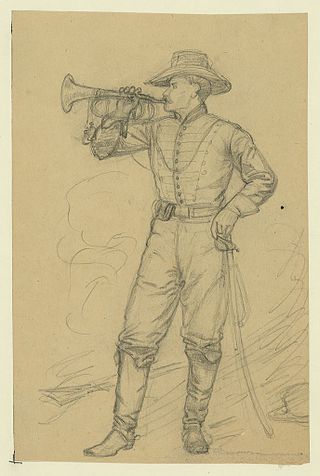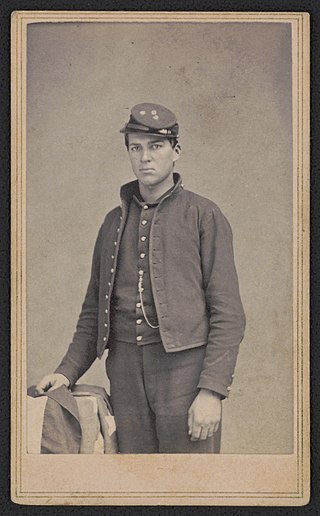
John Buford Jr. was a United States Army cavalry officer. He fought for the Union during the American Civil War, rising to the rank of brigadier general. Buford is best known for his actions in the first day of the Battle of Gettysburg on July 1, 1863, by identifying Cemetery Hill and Cemetery Ridge as good High Ground, and by placing vedettes to the west and north that delayed the enemy long enough for the Union Army to arrive.

George Stoneman Jr. was a United States Army cavalry officer and politician who served as the fifteenth governor of California from 1883 to 1887.

Wesley Merritt was an American major general who served in the cavalry of the United States Army during the American Civil War, American Indian Wars, and Spanish–American War. Following the latter war, he became the first American Military Governor of the Philippines.

Hugh Judson Kilpatrick was an officer in the Union Army during the American Civil War, achieving the rank of brevet major general. He was later the United States Minister to Chile and an unsuccessful candidate for the U.S. House of Representatives.

Theophilus Francis Rodenbough was born in Easton, Pennsylvania and was a Union Army officer during the American Civil War. He received America's highest military decoration the Medal of Honor for his actions at the Battle of Trevilian Station. After his retirement from the U.S. Army in 1870, he wrote several books about military history.

During the American Civil War, the State of Vermont gave strong support to the Union war effort, raising troops and money. According to Rachel Cree Sherman:
By the spring of 1865 Vermont was devastated, having sent one tenth of its entire population to war, with a loss of over 5,000 lives to battle, wounds, and disease. The state had dedicated nearly $10 million to support the conflict, half of that amount offered up by towns with no expectation of recompense.
The 6th Indiana Infantry Regiment was an infantry regiment from the State of Indiana that served in the Union Army during the American Civil War. This regiment was the senior Indiana regiment of the Civil War, as it was numbered first in sequence after the five Indiana volunteer regiments which had served in the Mexican–American War. The regiment was originally mustered-in for a three-month period of service between April and August 1861, but after its initial term of service had expired it was re-formed in September 1861 for a further three-year period, before being mustered out in September 1864.
The 7th Regiment Indiana Volunteer Infantry was an infantry regiment from the State of Indiana that served in the Union Army during the American Civil War.

James Parker Landis was an American soldier who served in the Union Army during the American Civil War. He received the Medal of Honor for the capture of a Confederate flag during the Battle of Amelia Springs while serving as the Chief Bugler of the 1st Pennsylvania Cavalry.

The 9th Regiment Massachusetts Volunteer Infantry was a military unit from Boston, Massachusetts, USA, part of the Army of the Potomac during the American Civil War. It is also known as "The Fighting Ninth". It existed from 1861 to 1864 and participated in several key battles during the war. The unit is an Irish heritage unit, with many volunteers having been born in Ireland.
The 6th Pennsylvania Cavalry was a Union Army cavalry regiment that served in the Army of the Potomac and the Army of the Shenandoah during the American Civil War. It was formed in 1861 as the Philadelphia Light Cavalry and the 70th Regiment of the Pennsylvania Volunteers by Richard H. Rush who also served as colonel from 1861 to 1862. At the request of Major General George B. McClellan, the regiment was equipped with lances which prompted the unit to be known as "Rush's Lancers." The lances proved ineffective in battle and the regiment was issued carbine rifles in 1863. The regiment served in many of the key battles in the Eastern theater of the American Civil War and were mustered out in August 1865.
The 17th New York Veteran Infantry Regiment was an infantry regiment that served in the United States Army during the American Civil War. It was often referred to as the 17th New York Veteran Zouaves and has been erroneously reported as using mules as mounts during Sherman's March to the Sea up until the Grand Review of the Armies. The regiment wore the Hawkins Zouave pattern uniform, which was first used by the 9th New York Volunteer Infantry, Hawkins Zouaves, and later was adopted by several other regiments including the 164th New York, 35th New Jersey and others.

Edwin Vose Sumner Jr. was a general in the United States Army. Born at Carlisle, Pennsylvania; he was the son of General Edwin Vose Sumner, one of the oldest generals to serve during the American Civil War.
The 22nd New York Cavalry Regiment was a cavalry regiment of the Union Army during the American Civil War.

The 1st Regiment New York Mounted Rifles, sometimes designated 7th Regiment New York Volunteer Cavalry, was a cavalry regiment of the Union Army during the American Civil War.
The following list is a Bibliography of American Civil War Union military unit histories. More details on each book are available at WorldCat.

The 8th New York Cavalry Regiment, also known as the "Rochester Regiment," was a regiment of the Union Army that fought during the American Civil War. It was a volunteer unit organized in Rochester on November 14, 1861, and left the state on November 29. It was mustered out on June 27, 1865.
Andrew Jackson Young was a United States soldier who fought with the Union Army during the American Civil War as a member of Company F of the 1st Pennsylvania Cavalry. He received his nation's highest award for valor, the U.S. Medal of Honor, for capturing a Confederate flag at Paines Crossroads, Virginia, on April 5, 1865. That award was conferred on May 3, 1865.

The 2nd New York Cavalry Regiment, officially known as the 2nd Regiment, New York Volunteer Cavalry, was a unit of the Union Army during the American Civil War. It served with the Army of the Potomac and fought in Stoneman's 1863 raid, the Wilson–Kautz Raid, and the Battle of Appomattox Station.

Richard Henry Rush was an American military officer who served in the United States Army during the Mexican-American War and the Union Army during the American Civil War. He mustered and served as colonel in the 6th Pennsylvania Cavalry Regiment from October 1861 to September 1862.















